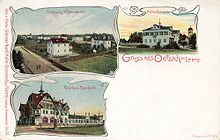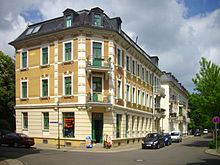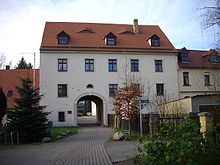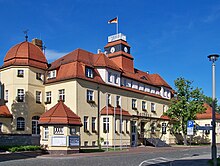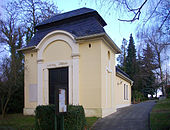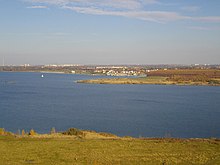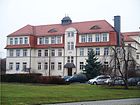Markkleeberg
| coat of arms | Germany map | |
|---|---|---|

|
Coordinates: 51 ° 17 ' N , 12 ° 23' E |
|
| Basic data | ||
| State : | Saxony | |
| County : | Leipzig | |
| Height : | 115 m above sea level NHN | |
| Area : | 31.44 km 2 | |
| Residents: | 24,748 (Dec. 31, 2019) | |
| Population density : | 787 inhabitants per km 2 | |
| Postal code : | 04416 | |
| Primaries : | 0341 (Markkleeberg), 034297 (Wachau district), 034299 (Gaschwitz district) | |
| License plate : | L , BNA, GHA, GRM, MTL, WUR | |
| Community key : | 14 7 29 260 | |
| LOCODE : | DE MKK | |
| City structure: | 8 districts | |
City administration address : |
Rathausplatz 1 04416 Markkleeberg |
|
| Website : | ||
| Lord Mayor : | Karsten Schütze ( SPD ) | |
| Location of the town of Markkleeberg in the Leipzig district | ||
Markkleeberg is a large district town in the Leipzig district in Saxony .
geography
The medium- sized town of Markkleeberg is located on the southern edge of Leipzig in the Leipzig district on the Pleiße river .
In addition to the city of Leipzig, neighboring municipalities are also the cities of Böhlen and Zwenkau and Großpösna .
Markkleeberg consists of the following districts:
|
|
earlier also:
history
The town of Markkleeberg was founded in 1934 as a merger of the places Oetzsch-Markkleeberg and Gautzsch. Since the National Socialists did not like the name of the by far larger community of Gautzsch because of its Slavic origins and the artificial suggestion Auenwalde could not prevail, the name of the smallest community of origin Markkleeberg was chosen as the name of the new town . All Slavic names of the districts were deleted, from Gautzsch to Markkleeberg-West , from Oetzsch with the incorporated Raschwitz to Markkleeberg-Mitte and - as a logical but nonsensical consequence - from the actually German name Markkleeberg Markkleeberg-Ost . Despite the renaming during the Nazi era , the old place names are still known and common today.
Later, the localities Großstädteln , Zöbigker (with Prödel and Cospuden), Gaschwitz and Wachau were incorporated, but they were allowed to keep their names. The incorporation of Markkleeberg into Leipzig on January 1, 1999, which had already been decided by the Saxon state parliament , was not implemented in 1999 due to a successful lawsuit by Markkleeberg at the Saxon constitutional court .
On October 16, 1813, the Wachau area was the main site of the Battle of the Nations , the most costly battle of the Wars of Liberation against Napoleon in Germany .
During the Second World War , from September 1944 to April 1945 there was a women's subcamp of the Buchenwald concentration camp in Wolfswinkel on parcel 270 on Equipagenweg for more than 1,000 Hungarian Jewish women and girls as well as 250 French resistance fighters of the Resistance who performed forced labor for Junkers Flugzeug- und Motorenwerke AG had to perform. As early as October 1943, a barrack camp had been set up there for forced laborers who worked in the worsted yarn spinning mill in Gautzsch for the engine construction branch in Markkleeberg (from Junkers). At the end of the war, Markkleeberg was exposed to Allied bomber attacks and was occupied by US troops on April 18, 1945 and, after their withdrawal, by Soviet troops on June 24, 1945.
In the GDR , Markkleeberg was best known for the agra-Markkleeberg agricultural exhibition .
The lignite opencast mines Espenhain , Zwenkau and Cospuden , south of Markkleeberg, ceased mining between 1990 and 1998 and have been rehabilitated and recultivated since then. New archaeological excavations on the well-known palaeolithic site of Markkleeberg became possible. In the meantime, large lakes and extensive forest areas with high recreational value have emerged in the post-mining landscape .
Population development
|
|
(Source since 1998: State Statistical Office Saxony)
politics
City council
Composition of the city council after the local elections on May 26, 2019 (with a profit or loss compared to the 2014 election):
| CDU | 7 seats | - 2nd |
| SPD | 6 seats | - 3 |
| GREEN | 4 seats | + 1 |
| AfD | 4 seats | + 4 |
| LEFT | 3 seats | - 1 |
| FDP | 2 seats | + 1 |
Then there is the mayor, who is the chairman of the city council.
Lord Mayor
On September 12, 2013, Karsten Schütze (SPD) was elected Lord Mayor of Markkleeberg with 67.7 percent of the valid votes. The predecessor was Bernd Klose (SPD), he had held the office for 19 years. Klose died in 2016.
coat of arms
Description : Split in gold and blue ; in front a red-tongued and armored black lion and behind a red-tongued lion divided into gold and silver ; both are facing each other.
Town twinning
Markkleeberg is the twin town of Pierre-Bénite (France), Zărneşti (Romania), Boville Ernica (Italy), Neusäß (near Augsburg) and Hemmingen (near Hanover).
Incorporation
During the last Saxon municipal reform in 1999, the city of Markkleeberg was to be incorporated into Leipzig . However, the city of Markkleeberg successfully sued and remains independent until further notice. The incorporation is still being sought, but it is assumed that it will not take place before 2019. A forced incorporation could also prove to be difficult, since the city now has the status of a major district town and its own distinctive infrastructure.
Culture and sights
- Gatehouse Markkleeberg
- In 1190 a Bere de Cleberg is mentioned in the contract for the sale of the village of Altranstädt. The old noble family owned a moated castle here , which was later built over with a manor and castle. From 1350 ownership changed, and in 1592 Calvinists found refuge in Markkleeberg. During the GDR era, the property was used as a Neubauerstelle, a children's hospital and a retirement home. In 1996 it was taken over by the Association Historisches Torhaus zu Markkleeberg in 1813 and opened a museum in 1998. There the history of the gatehouse, but also the role of the place in the battle of the nations, is illuminated. Another exhibition deals with former life in the country. Other historical rooms are used for events and private purposes.
- White House
- Paul Herfurth , an important newspaper publisher and royal Württemberg consul, acquired part of the former Raschwitz estate in 1896. He soon had it converted into a neoclassical park (today Agra Park ), with groups of trees, idyllic park ponds, temples, statues and colonnades. To this end, the white villa with its imposing gilded hall of mirrors was built by 1897.
- It was modeled on the Petit Trianon pleasure palace in Versailles palace gardens, the plans came from the Gautzsch master builder Gustav Hempel. The allegorical sandstone figures of the old Raschwitz baroque garden lined the terrace to the east. As Herfurthsche Villa, it was the meeting point of Leipzig's cultural life until World War II. During the war, parts of the district office were relocated there and in 1945/46 it was used as a remand prison for the Soviet military and secret service. The prisoners were often interned for months and dozens in the narrow basement rooms. Until 1981, the administration of the agricultural exhibition used the property, now known as the White House , as an office and, after a major renovation in 1986/87, as a ministerial accommodation during the agricultural exhibitions of the GDR , also known as agra-Markkleeberg . After a brief use as a hotel, the town of Markkleeberg acquired the property in the Markkleeberg area in 1996. During efforts to incorporate it into Leipzig in 1999, people insisted on spreading the slogan “The White House is in Washington and in Markkleeberg, never in Leipzig ”.
- The White House is now a popular place for cultural events again. The many rooms on the two upper floors of the Ottmar Gerster Music and Art School in the Leipzig district have been available since 2005 . The house also serves as the official registry office for the city of Markkleeberg.
- Town hall with Lindensaal in the Markkleeberg-Mitte / Oetzsch district
- Markkleeberg's town hall was built by converting the former stately Oetzscher Gasthof Zur Linde , and work on it was completed in 1921. In addition to its administrative function with the Großer Lindensaal, it serves as one of the most important venues for cultural events in Markkleeberg. Regular classical music concerts by the Leipzig Symphony Orchestra have also been held here since 2009 .
- Westphalian house
- The three-wing country house was designed in 1926 by the architect, painter and publicist Paul Schultze-Naumburg (1869 to 1949) for the general director of the Thuringian gas company Carl Westphal and built in 1927 in a neo-baroque style. From 1993 to 2005 the Westphalsche Haus was owned by Markkleeberg and served the city and its associations as a cultural meeting point and event location. In 2007 the lower floors of the main and east wings were carefully restored. In 2005 the house was sold to a private investor.
- Wachau church ruins
- The parish church of Wachau was the main church of the place and three other parishes in the surrounding area. It was mentioned for the first time in 1393 and belonged to the Buch bei Grimma monastery in the 16th century . After hurricane damage from 1867, the church was rebuilt in the neo-Gothic style by Constantin Lipsius. A British air mine and an American incendiary bomb devastated the place of worship during World War II. After that, church activities initially took place, but the state of preservation got worse and worse. In April 1975, parts of the tower were torn down and the rubble was poured into the nave. Since then, the church has been a ruin, memorial and monument at the same time. Church services and events have been taking place here again since 1997. The details that have been preserved, such as the painted ceiling in the altar area, are remarkable.
- Martin Luther Church
- The Martin Luther Church is located in the old town center of Gautzsch . It was built in 1717 in the baroque style and later redesigned by the architect Julius Zeißig. The interior offers space for 400 people. Worth mentioning are the baroque pulpit altar restored in 2006, the manorial boxes, several epitaphs, the marble baptismal font and the organ, which was rebuilt in 2014. Old gravestones can be seen on the outside wall of the church. In the Martin Luther Church Markkleeberg worked as cantors: from 1923 to 1963 Gustav Brand, from 1963 to 1965 Eberhard Ludwig, from 1965 to 2002 Helmut Packmohr, 2002–2008 Tobias Bantel and from 2008 to 2010 Alexandra Skiebe (interim) and since 2010 Frank Zimpel (evidence: see website of the parish, Markkleeberger Blätter No. 6 "Beautiful with pipes and cymbals" Publication by the town of Markkleeberg, there a list of all cantors since the Reformation)
- Alluvial cemetery
- On the outskirts of Markkleeberg-Ost is the Auenfriedhof on Dösener Strasse. It has existed for 500 years and is three quarters of a hectare in size. Despite its manageability, the facility has a number of special features. Of the 926 grave sites, 475 are grave monuments and 30 are listed. Many of the graves are very old and have been artistically designed. The grave chapel and a large population of trees are further peculiarities.
- Kees'scher Park
- The Kees'sche Park is the park of a former estate of the Kees family in Gautzsch, which the family acquired in 1861.
- Water tower
The water tower on the highest point of the Oetzscher Flur dominates the city skyline of Markkleeberg. It was built in 1902 to secure the city's water supply.
Memorials
- Memorial plaque on Equipagenweg in honor of these women who are victims of Nazism.
- Memorial stone on Rathausplatz for all victims of fascism
Experience / tourism
The urban area of Markkleeberg is characterized by several parks and gardens, for example the agra-Park and the Kees'sche Park. The Agra-Park was the location of the agricultural exhibition in the GDR . There are walking paths, flower beds, pavilions, the Spreewaldschänke, the palace-like park restaurant and the White House on the premises. In the north, the Leipzig-Connewitz wildlife park, a popular local recreation area, borders the Raschwitz district. In addition to red deer , fallow deer and mouflon , you can also see lynx , otters , wild cats , raccoons and other animal species. The German Photo Museum has been located on the site of the agra Park, not far from the White House, since August 2013 . In the permanent exhibitions approx. 800 exhibits are shown on an area of approx. 1,500 m², including around 500 photographs (including the two special exhibitions) and approx. 300 cameras.
With the Markkleeberger See and the Cospudener See, the city has two other important tourist destinations. There is a large network of cycling and hiking trails around the banks. Beaches offer the opportunity to relax and swim in summer. From the lookout points, the visitor has a view over the lake landscape and the Leipzig area. One of the most modern whitewater facilities in Germany is located at the Markkleeberger See , the Markkleeberg Canoe Park . With the Seepark Auenhain holiday village, there is also the beginning of a tourist infrastructure. In Markkleeberg-Ost, a panorama platform with a promenade and a beach café was created. At the Cospudener See there is a large harbor in the district of Zöbigker with cafes, shops, tourist information, promenade and the sculpture park. On the south bank there is a hill with the observation tower Bistumshöhe. Not far from there is the largest central German amusement park Belantis with its striking pyramid.
In addition, the newly reforested mixed forest area of Neue Harth on the former mining waste site is becoming increasingly important. There are several signposted circular routes that are equipped with information boards. Cross-country skiing on groomed trails is possible in winter. The Neue Harth is also home to rare plants such as St. John's wort and orchids.
A large part of the Grüner Ring Leipzig cycling and hiking trail is located in the Markkleeberg area. Extensive cycling and hiking tours are possible around the city, past Zwenkauer See and Störmthaler See in the wider area. Since 2004, the 7-Lakes Hike has been taking place every year at the beginning of May , which is also professionally accompanied by clubs and the DRK .
On the route from Leipzig to Rötha , the adventure route “ Fürstenstrasse der Wettiner ” leads via Markkleeberg, which has a certain relationship with the Wettins via Statz Friedrich von Fullen . Von Fullen served under four Saxon electors, including August the Strong, and made it up to the Privy Council of War .
Sports
Markkleeberg has also made a name for himself in sports. The pure football club Kickers 94 Markkleeberg , which was founded in 1994 as the unofficial successor to the insolvent 1. FC Markkleeberg , has played in the Sachsenliga since 2002 . The TSG Markkleeberg volleyball players attracted attention by moving up to the third division . Due to the downsizing of the third division, the team missed relegation and has been back in the regional league since then. The TSG volleyball players , who moved from SV Einheit Borna to Markkleeberg for the 2018/19 season , also play in the regional league. Both volleyball teams compete under the name Neuseenland-Volleys Markkleeberg .
Other sports clubs in the city of Markkleeberg are:
- RFC Markkleeberg
- TSV 1886 Markkleeberg
- TV 1871 Markkleeberg
- SV Oak Wachau
- SV Gaschwitz 09
- Riding club agra Markkleeberg: Equestrian sport (popular sport and tournament sport)
The canoe park is also an important training center for canoeing.
religion
In the area of today's Markkleeberg there have been four Protestant parishes since the Reformation in the first third of the 16th century : Markkleeberg with Meusdorf and Dölitz , Gautzsch with Oetzsch, Raschwitz, Cospuden and Zöbigker , Großstädteln with Gaschwitz and Großdeuben and finally Wachau . Currently (2010) there are three Protestant parishes: the Martin Luther parish Markkleeberg-West, formerly Gautzsch, with the Martin-Luther-Church, the Auenkirchgemeinde Markkleeberg-Ost with Dosen and Dölitz, to which the Johanniskirche in Dosen belongs, and the parish Großstädteln-Gaschwitz. The churches in Wachau and Zöbigker burned out in the 1940s and are now ruins. The district of Wachau is now part of the Leipzig parish Probstheida. Together the three Markkleeberg parishes have 3500 members.
On January 20, 2019, the two previously independent parishes of St. Peter and Paul Markkleeberg and St. Bonifatius Leipzig-Süd were merged and the parish of St. Bonifatius Leipzig-Süd was newly founded. The parish belongs to the diocese of Dresden-Meißen and includes Markkleeberg and Leipzig as well as the cities of Böhlen, Zwenkau and Pegau. About 1100 Catholics live in Markkleeberg itself. The parish church was built in 2000 and consecrated in March 2001.
Economy and Infrastructure
traffic
Markkleeberg is on the Leipzig – Hof railway line and on the Leipzig-Plagwitz – Markkleeberg-Gaschwitz railway line . On the first-mentioned railway line, there are three stops at Markkleeberg Nord , Markkleeberg and Markkleeberg-Großstädteln and one station at Markkleeberg-Gaschwitz . On this route, the S 5 and S 5X S-Bahn lines run every hour and the S 6 and S 4 run every 30 minutes. There are connections to Leipzig , Altenburg , Zwickau , Borna , Geithain , Halle (Saale) , Taucha , Torgau and Hoyerswerda via the S-Bahn Central Germany .
From November 25, 2012 to December 15, 2013, the eastern railway ring between Leipzig-Sellerhausen and Markkleeberg was completely closed due to construction work to integrate the city tunnel . For this reason, all train traffic was routed over the Leipzig-Plagwitz-Markkleeberg-Gaschwitz line. Even after the opening of the City Tunnel, the route will continue to be used for freight traffic. In addition to the Markkleeberg-Gaschwitz train station, the Markkleeberg West train station and the Markkleeberg Mitte stop are on the Leipzig-Plagwitz-Markkleeberg-Gaschwitz railway line.
The city of Markkleeberg is connected to the tram and bus network of the Leipziger Verkehrsbetriebe . Tram line 11 runs between Schkeuditz and Markkleeberg-Ost and is the LVB's longest tram line. Another tram line operated to Markkleeberg-West until 2015. Due to the competitor S-Bahn Mitteldeutschland and the poor condition of the tracks, tram line 9 was replaced by bus line 70, which was extended from Connewitzer Kreuz to Markkleeberg-West and is identical in rhythm and route.
Bus routes 65 (Markkleeberg– Markranstädt ) and 108 (Markkleeberg– Leipzig-Probstheida ) are other important bus routes in Markkleeberg. In addition to the bus lines of the Leipzig Transport operate in Markham with the 100 (Markkleeberg- Zwenkau - Groitzsch ), of the 106 ( Großstädteln - Leipzig-Probstheida or Großstädteln- Auenhain - Störmthal - Böhlen ) and 107 ( Leipzig-Connewitz -Markkleeberg-Zwenkau) also bus routes from Regionalbus Leipzig . Bus route 106 connects Markkleeberg-Ost, Markkleeberg-Mitte and Markkleeberg-West with each other. It runs every 30 minutes on weekdays.
Markkleeberg has been accessible from the A 38 via the Leipzig-Süd junction since 2006 . The B 2 runs as a four-lane expressway through Markkleeberg and crosses the agra-Park. It connects the A 38 with the center of Leipzig.
education
There are four primary schools in Markkleeberg, one each in Markkleeberg East, Middle and West and one in Großstädeln. In Markkleeberg-West there is a high school and a grammar school , the Rudolf Hildebrand School with an attached boarding school .
Healthcare
Since April 2008, the Bärenherz children's hospice has been located in Kees'schen Park since April 2008 .
Personalities
literature
- City of Markkleeberg (ed.): Markkleeberg. History and change. Pro Leipzig Verlag, Leipzig 2009, ISBN 978-3-936508-48-2 .
- Cornelius Gurlitt : Markkleeberg. . In: Descriptive representation of the older architectural and art monuments of the Kingdom of Saxony. 16. Issue: Amtshauptmannschaft Leipzig (Leipzig Land) . CC Meinhold, Dresden 1894, p. 81.
Web links
- Official website of the city of Markkleeberg
- Markkleeberg in the Digital Historical Directory of Saxony
- Link catalog on the subject of Markkleeberg at curlie.org (formerly DMOZ )
- Torhaus Markkleeberg - historical ensemble around the manor Markkleeberg and a history society
- Hidden story Markkleeberg
Individual evidence
- ↑ Population of the Free State of Saxony by municipalities on December 31, 2019 ( help on this ).
- ↑ Hidden history Markkleeberg
- ↑ https://wahlen.sachsen.de/Erresult_GR19.php?landkreis=14729&gemeinde=14729260&_ptabs=%7B%22%23tab-stimmengabe%22%3A1%7D
- ↑ http://www.lvz.de/Region/Markkleeberg/Markkleeberg-verneigt-sich-vor-Bernd-Klose
- ↑ Markkleeberg-Wolfswinkel, camp annexe de Buchenwald (French)
- ↑ Deutsches Fotomuseum: How to successfully market a special interest offer on sputnika.de from October 2, 2015, accessed on: September 6, 2019.
- ^ Protected flora and fauna in the Neue Harth. In: MASTERPLAN NEUE HARTH 2015 (p. 22). Retrieved May 5, 2017 .
- ↑ 7 lakes hike: Answers. Archived from the original on January 16, 2014 ; Retrieved May 5, 2017 .
- ↑ Markkleeberg-Ost parish
- ↑ Parish of Markkleeberg-West
- ↑ Photos of the establishment of the parish St. Bonifatius Leipzig-Süd. St. Bonifatius Leipzig-Süd, accessed on January 11, 2020 .
- ^ Catholic parish of St. Peter & Paul
- ^ Children's hospice Leipzig . Bärenherz Foundation website, accessed on May 9, 2012.



